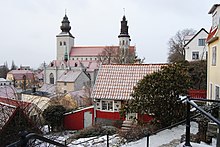Visby
The decline as a Hanseatic city in the Late Middle Ages was the cause for many stone houses being preserved in their original medieval style.
[8] The oldest finds at the site of present-day Visby are what have been interpreted as "beach huts", with the radiocarbon dating method to the 7th–9th centuries AD.
It was reshaped in the 13th century to its current appearance, and was officially opened in 1225,[10] by the bishop of the Swedish city of Linköping (in regional map).
Valdemar tore down part of the wall, set up three huge beer barrels and threatened to turn his men loose to pillage the town unless they were filled with silver and gold.
An invading army of Teutonic Knights conquered Gotland in 1398, destroyed Visby and expelled the Victual Brothers.
[15] In 1409, Grand Master Ulrich von Jungingen of the Teutonic Knights guaranteed peace with the Kalmar Union of Scandinavia by selling the island of Gotland to Queen Margaret of Denmark, Norway and Sweden.
[15] In 1411, the Norwegian, Danish and Swedish King Eric of Pomerania had the castle of Visborg constructed, and settled himself there for 12 years, during which the city virtually became a pirates' nest, and the commerce halted.
While Norby fought a military action in Sweden, the Lübeckers successfully attacked Visby and set the city on fire from four sites.
In 1533–34, the new Danish governor, Henrik Nielsen Rosenkrantz [da], demolished St. John's and St. Peter's churches to improve the defence of his castle Visborgs slott.
[18] In the mid 18th century, after a plague had reduced Visby's population, some attempts were made by Swedish government officials to improve living standards, but little was accomplished.
Visby is situated on the central west coast of Gotland, on the rather steep slopes of limestone cliffs surrounding the first natural harbor.
Long streets run parallel with the old shoreline with shorter alleys at a straight angle from these, lead from the harbor and up the slope up to the eastern higher part of town known as Klinten.
[23] The old, original part of Visby is more or less enclosed by the city wall to the north, east and south, with the old harbor and the Baltic Sea in the west.
[24] Visby and Tallinn are the only two North-European towns in which the city's medieval grid plan has been fully preserved into present day.
[33] Visby Airport is located about 5 km (3.1 mi) north of the city and offers connections to the Swedish mainland.
During the week, representatives from the major political parties in Sweden take turns giving speeches in the Almedalen park.
The festival started in 1984 and comprises a variety of events including music, jesters, theatre, a medieval market, and jousting tournaments.
The principal character, DS Anders Knutas, is based at police headquarters in Visby, and there are numerous descriptive passages of the city and the island.
Hayao Miyazaki noted that Visby is the main visual inspiration for the town in Kiki's Delivery Service, with elements of other locations such as Stockholm also blended in.
[45] In 1971, Ingmar Bergman filmed The Touch (Beröringen) with Bibi Andersson, Max von Sydow and Elliott Gould in Visby.





